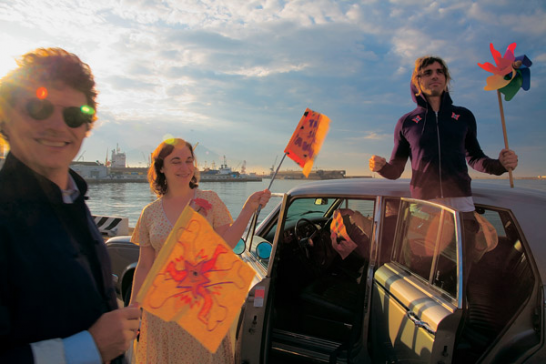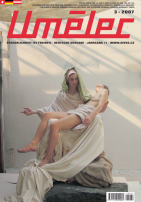| Umělec magazine 2007/3 >> THE SICILIAN PAVILION IN VENICE 2007 | List of all editions. | ||||||||||||
|
|||||||||||||
THE SICILIAN PAVILION IN VENICE 2007Umělec magazine 2007/301.03.2007 Dunia | biennale | en cs de es |
|||||||||||||
|
Sicily may very well be one of the most inspiring environments that this restless writer has ever set eyes upon. It isn’t immediately clear why contact and human communication in Sicily are carried out with such oldworld sophistication, it’s not an issue for the unique remnants of the class-defined society to be found in Palermo. To the sensitive observer, every encounter is a blast of multi-layered interaction. Physical motion is as much part of language as sound. Beauty is shared with foreigners if they happen to be around, but not to tourists, they are not considered foreigners, only tourists. That might be why Sicilians do not speak English; whether on the island of Levanzo, Palermo or some place or another between these two places and onwards to Catania, they appear to abhor the mere thought of any non-Italian language. This is a shame: an otherwise charming and helpful and good-hearted man has to remain ignorant about German coffee culture. It’s kind of embarrassing to explain that in Germany we really do have cappuccino; we’ve got Starbucks. Twenty year-old Sicilian beauties can not be spoken to because they do not consider English worth the effort. Some do show an understanding for this writer’s English, which, unlike the English of the British or of the United States, is an English of a third-language-dependent community (as you can see). Whereas this writer does speak and read a bit of Italian, this goes unnoticed by the locals. They just thank you for making the effort. But many in this community are artists and, since English accompanies comntemporary art culture, this might help fight a fear of foreigners. The Sicilian Pavilion project is outstanding. The—excuse my French—fucked up art world should concentrate on doing its job a little more and not be so busy chasing after the specter of fame. Most artistic directors and many artists are preoccupied chasing ghosts. But a rich and extremely inspiring art scene in Sicily thrives, yet remains unnoticed and seems somehow undead—as Schroedinger’s cat. This is a shame, and not because Sicily is famous for being a poor and turbulent region, still considered ‘third world’ in the Seventies by West German snobs; it’s another kind of shame, not like the patronizing exports of art festivals like the 2001 Tirana Biennale 2001 that Politi had established as a good and cheap idea, or the Prague thing, offers an alternative to a functionary-allied Prague Biennale, again Politi; or last but certainly not least: Manifesta 6, Nicosia, where this author had happened to be around writing as a guest of Nicosia based ARTs foundation, witnessing the colonial approach of a completely ignorant and uninformed art crowd that had taken the divided city by assault. Even though the author was won over by the integrity of some of Manifesta’s personel present on the island, in the end they all collapsed. As we know. No, the shame is different. This is because, as keen as Sicilian artists are for success and respect, as anybody would be, the creative mass of Sicily is somewhat fathomable. The author knows all this because she is about to take up a temporary writing residency in Sicily. The 2007 Venice Biennale didn’t know or didn’t care. In any case, a Sicilian pavilion had to be substituted for. Under the guidance of Palermo based curator, Paolo Falcone-- the unofficial ambassador for all things Sicilian in the so-called art world—we drove to Venice showcasing some of Sicily’s best. Sicilian artists Luca De Gennaro & Salvatore Prestifillipo were joined by global artist Aleksandra Mir, a Palermo resident for over a year now, and collector Marion Franchetti to give the cast that was being chauffeured to the opening of the 2007 Venice Biennale. Falcone of Palermo’s micromuseum answers one question:
Dunia : Africa and China have been recently added to Venice’s list of Pavilion hosts. The Sicilian Pavilion project somewhat bemoans the far away focus of the artistic direction. That may be a reason why it is prone to overlook regional cultures like that of Sicily. What can a region like Sicily, that is in size and population significantly smaller than Africa or China, contribute to the globalization of the art world except for the very obvious art market aspect? Paolo Falcone: With the Sicilian Pavilion, we want to focus on diverse aspects of Sicilian contemporary art. One focus is political as we are trying to get international attention for a regional art scene, for Sicily’s cultural stage, where no Biennale director has ever been seen doing research on the state of contemporary art. Only Harald Szeemann somewhat involuntarily visited Palermo in 2001, thanks to Maurizio Cattelan’s Hollywood 2001 project. But these days, no artistic director comes to have a look at the Sicilian art scene. It is probably because they are all busy in Bejing or Johannesburg. These places seem to be more trendy. Sicilian artists establish themselves in the international art scene by emigrating to New York. By way of the United States, the Sicilian artist Manfredi Beninati won the 2005 Young Talent Award in Venice. This is terrible for our artists, because they have to leave the island in order get anywhere. Sicily is one of the richest areas in the world in terms of cultural patrimony. But Sicily is also a place of a rich artistic landscape that is contemporary and full of contradictions. We wanted to export these contradictions to Venice, but the important gesture was this trip as an artistic appropriation of Long and Fulton’s of the Sixties, already with a furthered history of Pierre Huygue or Carsten Hoeller with his Laboratorium of Doubt (1999). The trip represents one heartbeat towards resolving the alleged contradiction between decadence and richness; for example Luca De Gennaro, who liked to play the double-sided role of traveling in a ‘77 Rolls Royce reading the ‘77 Punk Manifesto.
01.03.2007
Recommended articles
|
|||||||||||||








Comments
There are currently no comments.Add new comment